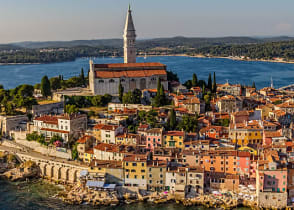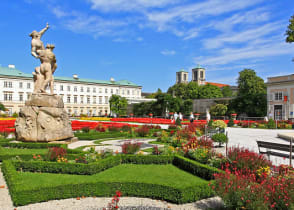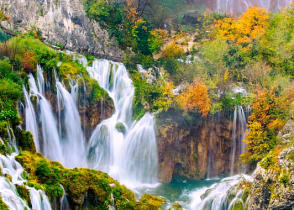DAY 3: SLOVENIA VISIT OF LJUBLJANA; PREDJAMA CASTLE & POSTOJNA CAVE (FULL DAY)
This morning, after again meeting with your guide and driver, you will transfer north and across the border with Slovenia.
Your first stop today will be Ljubljana. There you will be met by your local Slovenian guide for a walk through the Old Town district to take in the city’s ambience influenced by centuries of Latin, Slavic, and Germanic cultural influences.
You may start off in front of the Baroque Town Hall building, the seat of the municipal government, highlighted by its clock tower and the inner courtyard surrounded by pillars and arcades. You will continue to the Town Square, where you will see the famous Fountain of the Tree Rivers, which was originally designed in the second half of the 18th Century by the Italian Baroque sculptor Francesco Robba and became his most famous work. The figures with vases represent the rivers Ljubljanica, Krka, and Sava. Robba was inspired by Bernini's Fountain of the Four Rivers on Piazza Navona in Rome.
Just steps away from the Town Square, you will see the Cathedral of St. Nicholas – a popular landmark. This Baroque church was designed in the early 18th Century by a Jesuit architect to resemble a Latin cross. The interiors still contain much of the original Italian Baroque decor and frescoes. Left of the main altar, you can see the distinctive chair designed by Joze Plecnik - a famous Slovene architect who practiced in Vienna, Belgrade, Prague and Ljubljana. Plecnik transformed Ljubljana through works such as the Church of St. Francis, civic improvements including new bridges, the waterfront and the banks along the River Ljubljanica, as well as major buildings such as the monumental University Library.
Next, you may take the funicular which will take you to the top of Castle Hill. The Ljubljana Castle offers some great views over the city and the surrounding countryside. The castle was first mentioned in 1144 and was later enlarged and completely surrounded by a wall with towers and a drawbridge. Gradually losing its strategic importance in the area, the castle began falling into disrepair. In the early 20th Century, the castle was redesigned partially and used as a prison and a military stronghold. Since the 1970s, long and extensive renovation works have been underway.
Back in the Old Town, you may continue across the Dragon Bridge - an Art Nouveau masterpiece adorned with dragons and the symbol of Ljubljana, and stroll alongside the Ljubljanica River to the centrally located and bustling Preseren Square. It is named after Slovenia’s greatest poet who also wrote the lyrics to the national anthem. A statue of Preseren with a muse above his head is situated in the center of the square. On the south side of the square, the Ljubljanica River is crossed by the city's most famous bridge – the Triple Bridge, designed by Joze Plecnik, who added the side spans to the already existing central part of the bridge.
After taking some free time for independent exploration or lunch (lunch not included in the price of the tour) you may continue taking a short drive along the meandering mountain road to Predjama castle – a true masterpiece of medieval architecture. The castle was built under a natural rock arch high up a limestone cliff overlooking the valley. The first castle was actually a small fortress deep inside the cave to make it more inaccessible and easily defended. Over the centuries, the original Gothic castle was redesigned and reshaped many times, gradually moving away from the cave. The present castle was thus called Predjama, meaning ‘in front of the cave’.
Your next stop today will be the Postojna Cave – the longest cave system in Slovenia and one of its top tourist sites. The Postojna Cave has been attracting throngs of admirers from all over the world for over two centuries now. You will be able to visit this extraordinary cave and its curiosities with your guide and discover its unspoiled beauty. The Postojna Cave features an underground train, so you will be able to admire the sheer size and the powerful charm of its subterranean world, resplendent with huge stalactites and stalagmites forming some extraordinary shapes.
Arrival back to Istria in late afternoon hours.
Licensed Istrian English speaking guide throughout the dayLicensed local Slovenian English speaking guide in Ljubljana up to 4 hours Entrances Ljubljana including funicularEntrances Predjama castle and Postojna caveCoach mini-bus for the day as per itineraryOvernight exclusive Villa Gigi






